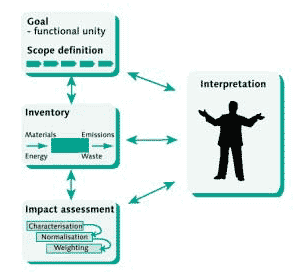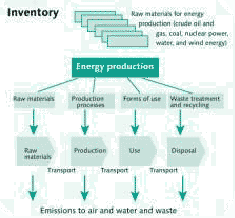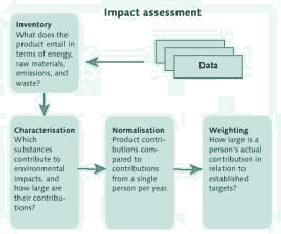Handbook on environmental assessment of products
1. Introduction
The objective of this handbook is to provide instructions on how to carry out life-cycle
assessments of one or more products in accordance with the life-cycle principle.
The handbook is based on the EDIP method, but a number of simplifications have been introduced in order to make the work easier while still ensuring reliable results. EDIP is short for Environmental Design of Industrial Products, in Danish UMIP – Udvikling af Miljøvenlige IndustriProdukter, a method developed by the Confederation of Danish Industries, five Danish companies, and the Institute for Product Development. This work was carried out during the period 1991 to 1996 with funding from the Danish Environmental Protection Agency.
The project "Stimulering af mindre virksomheders arbejde med renere produkter" ("Promoting small-scale enterprises' work with cleaner products") [Wenael et al., 1999] included the development of a very simple screening method for environmental assessments. Lessons learnt from that project have been incorporated into this handbook.
Emphasis has been placed on providing simple and specific instructions on how environmental assessments should be carried out. The objective of these instructions is to enable employees from small and medium-sized companies to carry out the tasks themselves.
1.1 Why carry out environmental assessments?In recent years, there has been a shift in developments within environmental issues: attention is no longer focused on processes and production forms. Instead, most issues are approached from a product perspective.
A "product perspective" means that a broader perspective is adopted: in addition to considering environmental issues associated with the actual production carried out at companies, attention is also given to the raw materials used: what happened to them before they arrived at the company? The question of what happens to the product once it has left the factory is also considered, including its impact while in use and when it is disposed of.
This holistic approach – or life-cycle perspective – is the foundation for Danish environmental policies. It takes on more concrete form in the Danish Environmental Protection Agency's strategy and action plans for the years to come and is commonly referred to as the "Product-Oriented Environmental Initiative".
Environmental issues are becoming a competitive parameter for many companies. Many of the stakeholders, customers, etc., of companies are interested in the environmental conditions or environmental standards for production and products. The environmental standards of companies can be illustrated by means of an environmental assessment in accordance with the life-cycle principle.
The life-cycle principle is a crucial element within many contexts. It is at the root of the criteria for eco-labels, environmental consumer information labelling, and other environmental assessments of products where the intention is to communicate information from manufacturers to consumers.
Environmental assessments according to the life-cycle principle are also gaining a firm foothold within production companies. For a number of years now, large-scale companies have addressed life-cycle aspect considerations in their product development, adjusting the materials used – both in terms of choice and quantity – on the basis of environmental assessments of the entire product life-cycle. The results of environmental assessments have also been used in connection with marketing.
1.2 How can small companies carry out environmental assessments?1.2.1. Preconditions
Embarking on an environmental assessment requires some insight into and interest in environmental matters. It also takes time. We recommend that environmental assessments are carried out in stages:
| Stage one can be carried out by the company itself, if it has an employee with experience of day-to-day environmental work. This step comprises the initial environmental assessment. | |
| Stage two requires significant knowledge about how environmental impacts are measured, and what they mean. Outside assistance will be necessary in most cases. This stage comprises the next steps of the environmental assessment and the expanded chemical assessment. |
If a small company has one or more persons who has already worked with environmental initiatives, e.g. preparation of environmental permits, environmental reviews of companies as a prelude to environmental management, or similar knowledge of environmental matters, a lot of the work can be carried out without any outside assistance.
The Handbook provides instructions on where it would be relevant to incorporate consultants or experts, and where it would be advantageous for companies to carry out the work themselves.
1.2.2 Who should carry out the work?
It is important that the management has actively decided that there is a need to carry out environmental assessment. It is also important that the management helps define the task. The management should decide:
| What the environmental assessment should be used for and who will use it. | |
| Which product/products will be assessed. | |
| What resources the company will allocate in the form of manhours from in-house staff as well as from external experts, etc. |
Once these matters have been decided on, it is important to assign responsibility for the task within the company. One person should be appointed as responsible for the overall project. The people who are to take part in the work carried out should also be identified. They should be familiar with environmental issues, production conditions, and procurement.
For successful results, it is important that the person responsible for the task has a certain level of competence within environmental matters. The person responsible should know how to measure and describe inputs – incoming flows of materials and energy – as well as outputs in the form of emissions to air and water.
In some cases, it is necessary to compile quite extensive data. As a result, it is important that the person responsible has the ability to work systematically, to assign the relevant priorities to the efforts made, and to create an overview of all the details of the task.
Naturally, the timeframe for completion of an environmental assessment depends on the product(s) chosen, on the relative difficulty of obtaining data, and on the prior knowledge of environmental assessments among the project participants. Completing the first stage of an environmental assessment which involves a comparison between two relatively simple products will take approximately 100 hours the first time it is done.
1.3 What are the principles of LCAs?The acronym LCA is short for Life-cycle Assessment. An LCA of a given product describes the most significant environmental conditions applying throughout a product life-cycle – right from the extraction of raw materials through production to use and disposal.
1.3.1 The method used
The main principles for carrying out an LCA are described in the international standards ISO 14040 to 14043.
The principles are based on four main elements. These are illustrated in Figure 1.1.

Figure 1.1
The main elements of an LCA
Figure 1.1 illustrates the usual progress back and forth between the various elements. For example, it is only natural to reassess the goals and scope definition once the inventory has been taken.
The principles used as the basis of this handbook take the four main elements as their point of departure. Start by going through these elements on a preliminary scale and draw your initial conclusions. You can then choose to establish a more detailed data basis and carry out the LCA for selected parts of a life-cycle or for the entire lifecycle. This is described in more detail in Chapter 2.
The four main elements and the most significant tasks within each element are described below.
1.3.2 Goal and scope definition
Start by establishing what you want to show with your environmental assessment. Identify what products the assessment should include, and what the results are to be used for. |
It is very important to define the goal of the environmental assessment. You also need to
be very clear on what you want to include in your impact assessment and what you wish to
omit.
First the product and its performance needs to be identified. For example, the performance of a coffee maker may be to brew 1 litre of coffee twice a day for five years.
If two or more products are being compared, they all need to be defined. This is important, as only products with identical performances can be compared. The approach is described in the Cookbook (part B), section 1.3.
The scope is defined by describing the total lifespan of the relevant product or products. The lifespan of a product is commonly divided into five life-cycle phases:
| Raw materials phase | |
| Production phase | |
| Use phase | |
| Disposal phase | |
| Transport phase |
The raw materials phase comprises extraction and processing of raw materials. This might, for example, involve extraction of iron ore which is then processed to form steel, or extraction of crude oil which is processed at a refinery to produce oil products. This is where you define which raw materials are included in the assessment.
The production phase comprises the company's activities in connection with production of the product itself. You should include all processes and activities that are important to the production of the product. The importance of these processes and activities is decided on the basis of consumption of raw materials, energy, and ancillary materials.
The use phase covers the activities that take place from the time the product leaves the company and until it is discarded. If the product in question is a refrigerator, its consumption of electricity is interesting. If it is a coffee cup, day-to-day cleaning is interesting. This phase is important for some products, whereas the use of other products does not involve issues of significance to the environment.
Disposal of the discarded product depends on the type of product in question. In Denmark, waste treatment of household waste and some industrial waste is mostly carried out by means of incineration. Recycling will be relevant for other types of discarded products. Often, the opportunities for recycling are determined by the choice of raw materials (metals can be recycled and reprocessed, while certain types of plastic cannot).
The transport phase comprises transport of raw materials to the manufacturer, transport from the manufacturer to the consumer, any transport taking place while the product is in use, and transport from the consumer to the place of recycling or incineration.
The Cookbook contains instructions on how to define the scope of product life (Part B, Chapter 2).
1.3.3 Inventory
All incoming and outgoing flows during the product life-cycle must be identified. The incoming flows comprise the raw materials, ancillary materials, and energy used. The outgoing flows comprise missions to air and water and waste. The main elements of the inventory are illustrated in Figure 1.2.
Energy, in the form of electricity, heat, and fuels, is used during the product's life-cycle. Generation of electricity and heat and extraction of raw materials for this purpose should be included in the calculations. This is illustrated at the top of Figure 1.2.
The inventory also involves assessment of the data used. The level of uncertainty associated with the data used and any lack of data should be considered.
The inventory is then interpreted with due consideration given to any uncertainties and lack of data. During this process, you should never lose sight of whether the original goal and scope definition is still appropriate for the work carried out.
A special PC tool has been developed for the EDIP method, consisting of a calculation programme with a database. The Handbook provides specific instructions on how to use a simplified version of the EDIP method which requires nothing more than a pocket calculator and a piece of paper. Also provided are instructions on when it may be relevant to use the PC tool, i.e. when a more detailed LCA is called for.

Figure 1.2
The main elements of LCA inventories
1.3.4 Impact assessment
The impact assessment involves three levels. These levels are based on the inventory and are arranged in logical succession. The three levels are known as:
| Characterisation | |
| Normalisation | |
| Weighting |
The correlation between the three levels of the impact assessment is illustrated in Figure 1.3.

Figure 1.3
The three levels of the impact assessment
1.3.4.1 Charactarisation
The total inventory extends to material and energy consumption, emissions, and waste from the entire life-cycle of the product.
"Characterisation" means that the inventory is translated in terms of environmental impact. A set of environmental effects has been defined, with each effect illustrating the impact on certain conditions within the surroundings. Some effects show something about impacts in the immediate environment, while others demonstrate impacts within a wider perspective and yet others illustrate impacts on e.g. human beings.
Emissions and waste are classified in accordance with the environmental impacts to which they contribute. For example, carbon dioxide contributes to the greenhouse effect, while sulphur dioxide contributes to acidification. Some substances contribute to several impacts simultaneously. Calculations of environmental impacts are carried out by means of various units. The greenhouse effect, for example, is measured in CO2 equivalents. All emissions contributing to the greenhouse effect are converted into CO2 equivalents. This is precisely what is known as "characterisation".
The method used here groups the impacts into three categories: global, regional, and local impacts. The effects are illustrated in Table 1.1.
The incoming flows – consumption of raw materials and energy – are included in the inventory of resource consumption. The values for consumption of raw materials and energy are calculated for each individual type of material.
Each of these impacts "measures" different aspects of the environmental impacts. They cannot be compared directly, nor can they be assessed as a whole.
Table 1.1
Environmental impacts
Category |
Impact |
Substances contributing to the impact |
Global |
Greenhouse
effect Ozone depletion |
Carbon dioxide and other greenhouse gases. CFCs and other, similar substances which degrade the ozone layer. |
Regional |
Acidification |
Acidic
compounds, mainly of nitrogen and sulphur, which cause acid rain. |
Local |
Human
toxicity |
Emission
of toxic substances which may affect human beings in the short term. |
1.3.4.2 Normalisation
Normalisation means that the environmental impacts are considered in relation to the average impact caused by a single person.
Normalisation of resource consumption means that the relevant consumption is considered in relation to the amounts of the relevant resource consumed by an average person during a single year. The environmental impacts are compared to the average contribution caused by a single person. During normalisation, calculations of resource consumption and environmental impacts are carried out in person equivalents.
The objective of normalisation is to provide targets for the relative size of environmental impacts and resource consumption in relation to the overall environmental impact. Normalised environmental impacts and resource consumption can be compared.
1.3.4.3 Weighting
The significance of resource consumption and environmental impacts seen within an environmental perspective can be expressed by converting the normalised person equivalents to a weighted person equivalent.
Weighting means that resource consumption for each individual raw material is placed in relation to the so-called supply horizon, i.e. the share of the resource available to a person and all his/her descendants at global level. The weighted resource consumption is calculated in Person Reserves, often expressed in milli-Person Reserves, mPR.
When weighting environmental impacts, each individual environmental impact is compared to the political reduction target (for Denmark or for the world). The weighted environmental impact is calculated in milli-person equivalent-targeted (often shown as mPEM).
When you carry out an impact assessment of a product, the most significant environmental impacts and types of resource consumption can be determined. It is also possible to identify the conditions which make them so significant.
When comparing two products, resource consumption and environmental impacts are compared individually. This makes it possible to identify the most significant impacts as well as the conditions governing the relative environmental impact of the two products.
This method recommends the use of weighted results. Weighted results incorporate an assessment of the relative significance of the environmental impacts. |
Please note that the normalised and weighted results of the inventory are based on the
principles of the EDIP method. If these results are compared to environmental impact
assessments carried out in accordance with other methods, differences may occur.
Figure 1.1. illustrates how interpretation is relevant to each of the three other elements (goal and scope definition, inventory, and impact assessment).
When carrying out interpretation, it is important to:
| Compare the results of the impact assessment with the goals established | |
| Take into account the scope definition and preconditions established at the outset and during the course of the project. | |
| Take into account any uncertainties and lack of data in the inventory. |
The impact assessment, based on weighted environmental impacts and resource consumption, must be interpreted and compared against the goal of the environmental assessment.
It will not always be possible to draw the conclusions you need. For example, lack of data, elements of uncertainty, or necessary delimitations may mean that it is impossible to identify differences or similarities between two products. This is why figure 1.1. shows that it may be necessary to return to a previous step to carry out additional work or adjustments.
1.4 ReferencesThe principles of the simplified method are described in Chapter 2, and Chapter 3 provides examples of what environmental assessments can be used for – and what they cannot be used for.
A more in-depth description of the actual method and its principles would be beyond the scope of this Handbook. For information on these issues, please refer to the EDIP books [Wenzel et al., 1996].